Muscle contraction refers to the slip of actin over myosin in muscle cells, allowing the body to move.
Muscle fibers contain the contractile protein filaments of actin and myosin, arranged side by side. These filaments are repeated along the muscle fiber, forming the sarcomere.
The sarcomere is the functional unit of muscle contraction.
For muscle contraction to occur, three elements are needed:
- Stimulation of the nervous system;
- Contractile proteins, actin and myosin;
- Contraction energy provided by ATP.
How does muscle contraction occur?
Understand the step-by-step mechanism of muscle contraction in a skeletal muscle fiber:
The brain sends signals, through the nervous system, to the motor neuron that is in contact with the muscle fibers.
When close to the surface of the muscle fiber, the axon loses myelin sheath and expands, forming the motor endplate. Motor nerves connect to muscles through motor plates.

Motor neuron axons in contact with muscle fiber
With the arrival of the nerve impulse, the axon endings of the motor nerve release onto its muscle fibers the
acetylcholine, a neurotransmitter substance.Acetylcholine binds to muscle fiber membrane receptors, triggering an action potential.
At that moment, the actin and myosin filaments contract, leading to a reduction in the sarcomere and consequently causing muscle contraction.
Muscle contraction follows the "law of all or nothing". In other words: the muscle fiber contracts completely or not at all. If the stimulus is not enough, nothing happens.
Types of Muscle Contraction
Muscle contraction can be of two types:
- isometric contraction: when the muscle contracts, without shortening its size. Example: posture maintenance involves isometric contraction.
- isotonic contraction: when contraction promotes muscle shortening. Example: lower limb movement.
Read more about it:
Muscle tissue
Muscle System
Muscles of the Human Body
